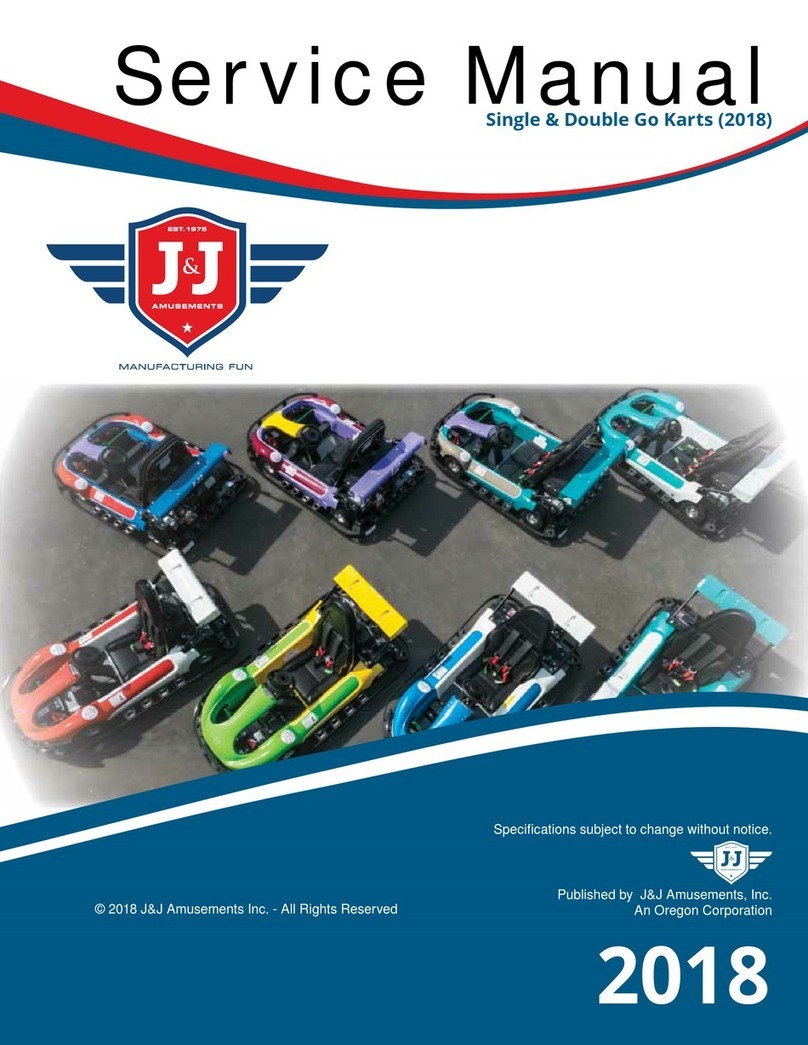
0General data and
maintenance.
1Tubes, tires, rims
2Frame, bumpers,
nerf bars
3Front hubs,
spindles
4Steering system
5Roll bars, pads,
seatbelts
6Axle, axle cover,
drive system
components
7Brake system
8Engine, clutch,
engine mounted
accessories
Specifications.............................................. 0-1
Scheduled maintenance..............................0-8
Service schedule - gas.................................0-9
Service schedule - electric .........................0-11
Maintenance records..................................0-12
Pre-opening checklist - gas ........................0-13
Pre-opening checklist - electric..................0-14
Go-kart track area checklist.......................0-15
Non-scheduled maintenance record..........0-16
Work order tags .........................................0-17
How a warranty is processed.................... 0-20
Product return procedures ........................ 0-20
Limited warranty....................................... 0-21
Cleaning go-karts...................................... 0-22
Unloading go-karts.................................... 0-23
Initial setup ............................................... 0-26
Tube & rim information................................1-1
Frequent questions.......................................1-2
Rotating tires................................................1-2
Disc-lock lug nuts ........................................1-3
Wheel removal ............................................1-5
Changing tires & tubes ................................ 1-6
Tire & wheel inspection.............................1-10
Troubleshooting tires..................................1-11
Frequent questions (frame)...........................2-1
Frequent questions (bumper)........................2-2 Bumper & D-rubber removal .......................2-3
Nerf bar removal..........................................2-5
Steering system ........................................... 4-1
Caster.......................................................... 4-3
Toe-in..........................................................4-6
Tie rods/ends...............................................4-8
Ackerman effect.........................................4-10
Steering shaft & cover ................................4-11
Steering wheel ...........................................4-12
Steering column pad ..................................4-13
Engine overview............................................ 8-1
Grabber plate.............................................. 8-3
Engine assembly removal.............................. 8-4
Engine-mounted items.................................8-6
Hour meter schematic (without kartrol)....... 8-7
Hour meter schematic (with kartrol)............ 8-8
Tiny tach schematic...................................... 8-9
Clutch/reduction rebuild............................8-14
Overview.....................................................7-1
Caliper assembly..........................................7-3
Brake pads - removal & installation............. 7-4
Removing brake caliper assembly ...............7-5
Master cylinder overview.............................7-9
Master cylinder removal.............................7-10
Brake pedal................................................7-13
Brake fluid level inspection........................7-14
Brake fluid change......................................7-14
Bench-bleeding master cylinder.................7-15
Bleeding the brake system..........................7-17
Brake troubleshooting................................7-18
Drum brake system overview.....................7-19
Drum brake parts identification..................7-20
Changing brake shoes ................................7-21
Drum brake adjustments............................7-27
Frequent questions...................................... 5-1
Roll bar (Eagle, Scorpion, Can-Am, F-22, Sidekick) ........ 5-2
Rollbar(Sidewinder, Sidewinderdouble)......................5-3
Seat back pads ............................................5-4
Fixing pads..................................................5-6
Seatbelts...................................................... 5-7
Cleaning seatbelts....................................... 5-9
Overview.................................................... 6-2
Axle cover................................................... 6-3
Drive cover .................................................6-4
Drive belt....................................................6-6
Drive hub...................................................6-11
Drive pulley ...............................................6-12
Floater hub.................................................6-14
Axle bearing overview ...............................6-16
Bearings .....................................................6-17
Axle - single drive ......................................6-19
Axle - two-wheel drive.............................. 6-26
Drive sprocket spreadsheet ....................... 6-27
Frequent questions (hubs & spindles).......... 3-1
Front hub removal....................................... 3-3
Spindle........................................................3-4
Tapered spindle & roller bearings................ 3-5
Spindle dissassembly...................................3-8
Spindle assembly......................................... 3-9





























